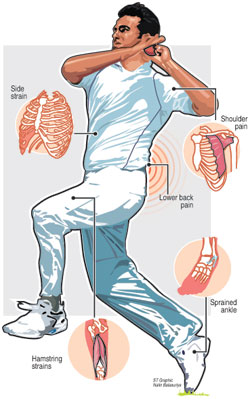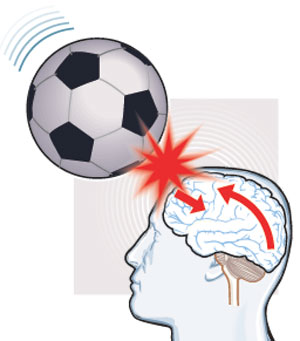Tackling injuries
View(s):With the big match season in full swing Consultant Rheumatologist Dr. Harindu Wijesinghe discusses player-safety
By Kumudini Hettiarachchi
It’s that time of year when schools battle each other on the sports field – with an emphasis on wielding the willow or attempting to secure the ball in a scrum.
There are also the sports meets with athletic events galore – running, hurdles et al happening on the field these days.
But what of sports injuries?
“Injuries are a common occurrence on the field,” says Consultant Rheumatologist Dr. Harindu Wijesinghe, stressing, however, that it is not only important to try and prevent them but also be aware how to deal with them.
The initial management of an injury or an illness is crucial, while those engaging in competitive sports should not be “in a hurry” to return to the field too soon.

To prevent an athlete from getting injured is the focus of sports medicine which is of special interest to Dr. Wijesinghe and he says that “prehabilitation” is now being implemented to minimise injury and also enhance performance legally.
It is of utmost importance for any player who suffers a major injury to stop playing immediately, he cautions, adding that the first 72 hours after an injury is the “golden” time and it is vital to take measures that would relieve the pain, reduce the swelling and quicken the healing process, with the formula being ‘PRICE’.
P – protection
R – rest
I – ice
C – compression
E – elevation
Picking on the need to place ice, he is quick to point out that ice should not be applied directly on the injury site, but as an ice-pack or ice rubbed in a towel or handkerchief. The ice should be in place for at least 15 minutes at a time for two-three hours soon after the injury. Compression with a crepe bandage is needed particularly in ankle injuries, according to him, as is also elevation, if a lower limb is injured.
The other measures would be painkillers to reduce pain and keeping the injured site without movement. Later would come rehabilitation including physiotherapy modalities to reduce swelling through the ultrasound machine and in severe injury there would be splints, slings, casts, manipulations or surgery, it is learnt. The common sports injuries include sprains, strains and knee injuries while fractures and dislocations are less common, MediScene understands.
The commonest sports injuries are linked to joints, says Dr. Wijesinghe, pointing out that they have a unique structure. It is where two bones meet and there are soft tissues such as muscles around it to enable movement, rubbery cartilage to cushion the friction, rope-like ligaments to give stability and tendons to connect muscle to bone. According to him:
- Sprains and strains – a sprain is a stretched or torn ligament while a strain is a stretched or torn muscle or tendon. Sprains may result from a fall, twist or hit and a strain with a stretch.
- Knee problems – could follow ligament and tendon injury, with anterior cruciate ligament (ACL) occurring from a sudden twisting motion.
- Fractures – a break or shattering of one or more bones.
- Dislocations – joint injuries which push bones out of position. Ankles, knees, shoulders, hips, elbows and finger and toe joints can all get dislocated.
Before, singling out a sport and injuries linked to it, Dr. Wijesinghe says there could be two groups of injuries on the field – acute traumatic injury or over-use or chronic injury. Under the first group would fall fractures, strains and sprains and under the second those such as stress fractures (tiny cracks on the bone surface) and tendinitis (inflammation of the tendon) that happen over a period of time due to repetitive action.
Dr. Wijesinghe then deals with sports-specific injuries:
Cricket –
Lower back pain — young fast bowlers may become victims of stress fractures of the lower back due to the repetitive action of bowling for long spells,while fielding for long periods and bending to stop the ball could also cause this injury. Monitoring of bowling practice is essential to prevent this. Heat packs, rest and physiotherapy are the answers.
Hamstring strains – a tear in muscle tissue due to sprinting to bowl, take a single or field a ball. To prevent such injury over-bowling needs to be avoided while a warm-up before cricket is advisable. The answer to hamstring strains is RICE, without the P in PRICE. Side strain – bowlers may suffer a tear of the fascia attached to the four bottom ribs, on the non-bowling arm side. Muscle function should be improved to prevent this injury and over-bowling avoided. An ice-pack, a compression bandage and physiotherapy should help if it occurs.
Shoulder pain – the repetitive actions of throwing and bowling may result in the Rotator Cuff muscles around the shoulder joint getting injured. Beginning as an inflammation, if not treated, will lead to a muscle tear. The risk could be reduced by correct throwing and bowling while physiotherapy will cut down inflammation. If there is a tear, medical treatment will be required.
Sprained ankle – when ligaments and soft tissue around the ankle get damaged. The ankle could be braced or taped to reduce the risk but if damage occurs the PRICE formula should be applied. All injured ankles should also generally be taped or braced to prevent a recurrence.
Rugby –
Ankle, hamstring and ligament sprains, cartilage injuries particularly within the knee, shoulder dislocations (during a tackle) and tears of the acromioclavicular and coracoclavicular ligaments could occur. Such tears could lead to the clavicle (collar bone) being raised resulting in a bony lump on top of the shoulder
Soccer or football –
The common injuries are ankle sprains followed by hamstring pulls or tears and muscle pulls or strains. Tendonitis or stress fractures could come about due to repetitive play.
Basketball –
Sprained ankles are common while fractures and ligament tears can occur as also finger injuries, bruises, bloody or broken noses and poked eyes. Tendonitis in the wrist, knee and ankle are some of the other injuries.
Running –
Sprained ankles, blisters, tendonitis, chondromalacia (runner’s knee – wear and tear of cartilage behind the knee cap), groin pulls, heel spurs and hamstring pulls are some of the injuries. Warming up, being well-hydrated to ward off heat stroke and wearing good light running shoes with thick, shock-absorbing soles are important.
If an injury occurs, reiterates Dr. Wijesinghe, there should be proper diagnosis and rehabilitation to enable the person to return to the sport. Stretching and strengthening the affected joints will progress from basic exercises to the more advanced.
“Once the pain reduces and muscle strength is established, more sports-specific exercises should be performed,” he says citing the example of running with the ball in rugby at first. Competitive sports should be resumed only after that.
The recovery would depend on the injury, he says, adding that if surgery is required for a severe knee injury, the post-surgical rehabilitation period would be at least nine months to one year. However, a minor ankle injury would enable a return to the field in 3-6 weeks.
The need is for the right techniques and right accessories, gear and equipment to be deployed to prevent sports injuries.
Head and neck injuries
A severe fall, violent jolting or hard blow in sports like rugby and football can cause serious head injuries which include concussion (severe jarring which may jolt the brain), fractures and haematomas (bleeding in the brain covering or inside the brain itself), says Dr. Wijesinghe, advising close fielders in cricket to wear helmets.

If a player gets a severe blow to the head and loses consciousness, cannot remember the event or appears disoriented, he should be taken off the field and medical care sought immediately.
Sudden jerking of the head in rugby, gymnastics, judo, boxing or diving can also cause whiplash, he says, stressing that if a person is suspected to have suffered a neck injury it is crucial to make him lie still with the head held straight and call a doctor immediately. For, incorrect handling of a neck-fracture could result in permanent paralysis or even death.
Follow @timesonlinelk
comments powered by Disqus




















